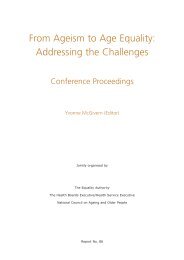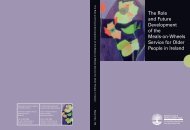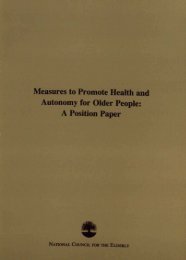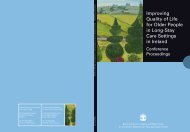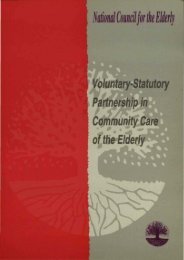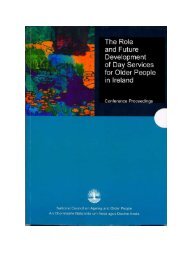Improving Quality of Life for Older People in Long-Stay Care ...
Improving Quality of Life for Older People in Long-Stay Care ...
Improving Quality of Life for Older People in Long-Stay Care ...
- No tags were found...
Create successful ePaper yourself
Turn your PDF publications into a flip-book with our unique Google optimized e-Paper software.
9.5 PrivacyThe degree <strong>of</strong> privacy enjoyed by resident respondents largely depended onwhether they had a room <strong>of</strong> their own or not (Table 9.6). Respondents who lived<strong>in</strong> large open-plan wards <strong>in</strong> public facilities experienced the greatest lack <strong>of</strong> privacy.Many reported that it was a struggle to have any k<strong>in</strong>d <strong>of</strong> private life. The curta<strong>in</strong>saround their bed were the only means they had <strong>of</strong> shutt<strong>in</strong>g out the rest <strong>of</strong> the ward.However, curta<strong>in</strong>s provided visual privacy only and many commented that evenwhen they were closed, ‘everybody knows what’s go<strong>in</strong>g on’. Staff respondentswork<strong>in</strong>g <strong>in</strong> these facilities also reported that they found it difficult to ma<strong>in</strong>ta<strong>in</strong>residents’ privacy. For example, the cramped space made it difficult to keep thecurta<strong>in</strong>s closed when us<strong>in</strong>g bulky equipment. The lack <strong>of</strong> a day room <strong>in</strong> somefacilities exacerbated the problem. Reality <strong>for</strong> residents liv<strong>in</strong>g <strong>in</strong> these facilitiesis that their world shr<strong>in</strong>ks to the space around their bed. All activities – eat<strong>in</strong>g,sleep<strong>in</strong>g and socialis<strong>in</strong>g, are carried out <strong>in</strong> or beside their bed aga<strong>in</strong>st the backdrop<strong>of</strong> a large, noisy ward. Residents who were fit and active had the option <strong>of</strong> tak<strong>in</strong>ga walk outdoors or go<strong>in</strong>g ‘down town’. Those who were physically dependent hadlittle option but to ‘put up with it’. Many respondents longed <strong>for</strong> a private room butbelieved that there was little hope <strong>of</strong> gett<strong>in</strong>g one. Residents who lived <strong>in</strong> two orthree bedded rooms had fewer issues. They tended to be positive about shar<strong>in</strong>gand liked the company. Many <strong>of</strong> the private study sites had a few two or threebedded wards. In these facilities, resident respondents who shared usually hadopted to share rather than have a room <strong>of</strong> their own; it was their choice, unlikeresident respondents <strong>in</strong> large open plan wards who had no other option.177Respondents who had a room <strong>of</strong> their own had a degree <strong>of</strong> privacy and controlnot open to residents liv<strong>in</strong>g <strong>in</strong> multiple occupancy rooms. Hav<strong>in</strong>g a room gave themchoices. They could choose to jo<strong>in</strong> other residents or had the option <strong>of</strong> retreat<strong>in</strong>gto their room if they wanted to be alone. Hav<strong>in</strong>g a door literally meant that theycould shut out the rest <strong>of</strong> the world if that was what they chose. A room <strong>of</strong> theirown also freed them from the worry <strong>of</strong> disturb<strong>in</strong>g others. They could choose towatch television or turn up their radio if they wished.There were some differences between staff and resident respondents’ perceptions<strong>of</strong> privacy and what was important. Staff respondents focused on physical privacymore so than resident respondents. They tended to highlight the importance <strong>of</strong>ensur<strong>in</strong>g that curta<strong>in</strong>s and doors were closed when provid<strong>in</strong>g <strong>in</strong>timate care. Relativesraised similar concerns. However, resident respondents rarely raised this as anissue. The issue <strong>for</strong> them was that staff rarely knocked and tended to ‘barge’ <strong>in</strong>.In contrast to staff, resident respondents prioritised social and psychological privacyrather than physical privacy. More problematic <strong>for</strong> them was the lack <strong>of</strong> ‘peace







